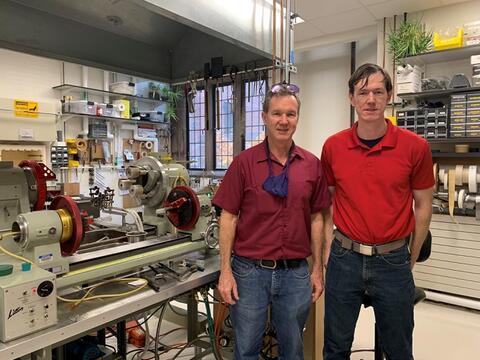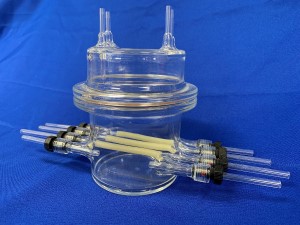
As the scientific glassblowers for Yale, Daryl and Preston Smith create glass apparatus to be used in research by the STEM community. The father-son team makes glassware for Chemistry and 16 other departments as well as other universities and businesses across the U.S. One week they built vessels to test catalysts for alternative energy sources, and in another, they produced 200 green glass gallbladders for an art gallery display.
Among the precision lathes and hot ovens of the Scientific Glassblowing Laboratory on Science Hill, we met them for a Q&A to learn about the high-quality glass devices available to researchers.
| Daryl Smith | Preston Smith | |
| TITLE | Senior scientific glassblower | Assistant scientific glassblower |
| YEARS GLASSBLOWING | 35 total, 16 at Yale | Making trinkets since the age of five, 5 at Yale |
Can you explain the process involved in making glass apparatus?
Daryl: In lampworking, we use gas oxygen torches to melt, shape, and fuse pre-made components, rods, and tubing to fabricate laboratory apparatus. The glass we use – borosilicate – has a high melting point, handling temperature change quite well. In fact, you can cook with it. That’s what Pyrex glass from Corning is.
We also use quartz, which has a very high melting point, low optical absorption, high resistance to high-intensity laser radiation, and rapid heating and cooling.
Preston: When you’re working with glass, it becomes more viscous as you heat it, and it starts to flow. So you need to rotate the glass to keep it from falling or slumping in a way that you don’t want.

What is the range of items you make here in the shop?
Daryl: We can do small to very large glassware. We stock items that you find in online catalogs, and we can also do completely custom, one-off ideas of something that’s never been done before.
How do you help people with the brainstorming and design process?
Daryl: Researchers will come down with a previously published article that describes the methods and materials but not much technical information as far as the design work and say, “help me replicate this experiment.”
“We tell people anything to do with glass, any questions you have, any needs you have, come see us because if we can’t make it for you, we have connections in the American Scientific Glassblowers Society (ASGS) and can find a solution. We have the collected knowledge of all the glassblowers in the country. Because they are in research, they may have worked on something similar.”
Preston: As members of the ASGS – the professional society for our craft – we exchange techniques and knowledge through paper presentations, seminars, and workshops at the annual symposium and regional meetings.
What’s the process for a researcher if they want to work with you?
Daryl: They can email, call, or zoom, but the most favorable and timely results are achieved through in-person collaboration. We can also utilize CAD drawings (Computer Aided Design), go back and forth with that, and finalize the decision. In some cases, design, testing, modification, and retesting can be performed in one day.
 I see you have an intricate glass device there, like a fancy mason jar with tubes and hoses running through it. What was that used for?
I see you have an intricate glass device there, like a fancy mason jar with tubes and hoses running through it. What was that used for?
Daryl: This is a glass biomimetic bioreactor I made for the Department of Biomedical Engineering to build collagenous tissue replacement in patients. The researchers seeded vascular cells onto a degradable substrate, represented by the amber latex tubing, to culture vascular tissues. The result is an engineered extracellular matrix-based graft that is available to patients.
What do you love most about your job?
Daryl: I do like problem-solving. It’s a kick, working directly with the researchers, making something that’s successful, and then getting the results that they want. It’s a thrill, you know.
Preston: It’s a similar thing for me – the positive feedback. I also like working with my hands and having something I can show. This is what I did, and it’s kind of cool.
Check out the Scientific Glassblowing Laboratory for more information and contact Daryl Smith for a consultation.